Healthcare Ethics and Professional Conduct: An Analysis of Amos's Case
VerifiedAdded on 2021/06/16
|9
|2413
|86
Essay
AI Summary
This essay presents a detailed analysis of a healthcare ethics case study involving a patient named Amos who died after being denied treatment at a school clinic due to discriminatory practices by a nurse. The essay explores the ethical issues, including violations of human rights, human dignity, the principles of beneficence and justice, and professional negligence. It examines these issues in relation to healthcare ethics principles, professional codes of conduct, and the UN's bioethics principles. The analysis highlights the nurse's failure to act in the patient's best interest, the violation of the principle of justice, and the breach of professional negligence. The essay recommends that the nurse should be charged with professional negligence, and that training for nurses is essential to address ethical dilemmas, promote accountability, and ensure adherence to ethical standards. The essay concludes by emphasizing the importance of critical decision-making in healthcare to protect patient rights and dignity, and to mitigate the negative consequences of ethical violations.
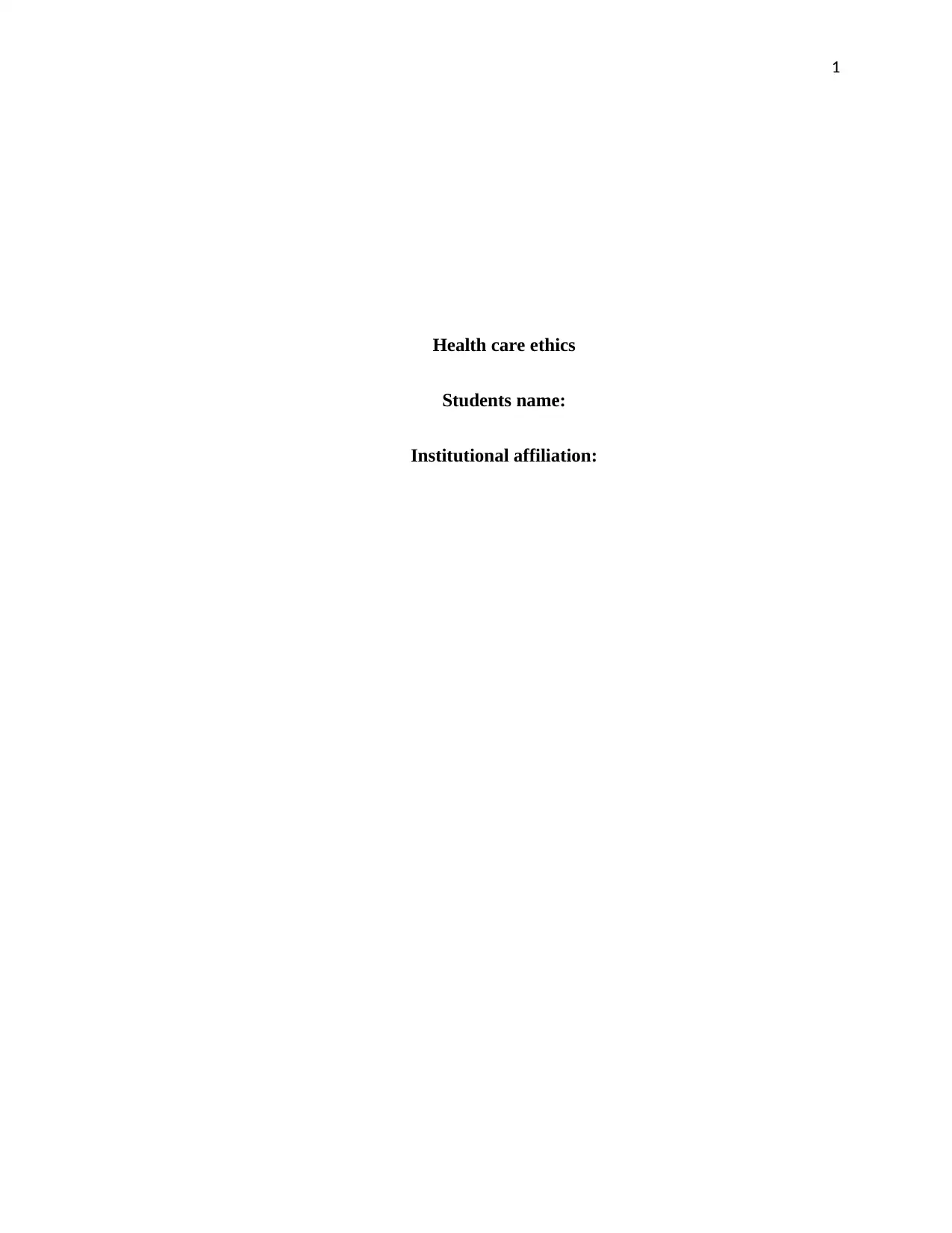
1
Health care ethics
Students name:
Institutional affiliation:
Health care ethics
Students name:
Institutional affiliation:
Paraphrase This Document
Need a fresh take? Get an instant paraphrase of this document with our AI Paraphraser
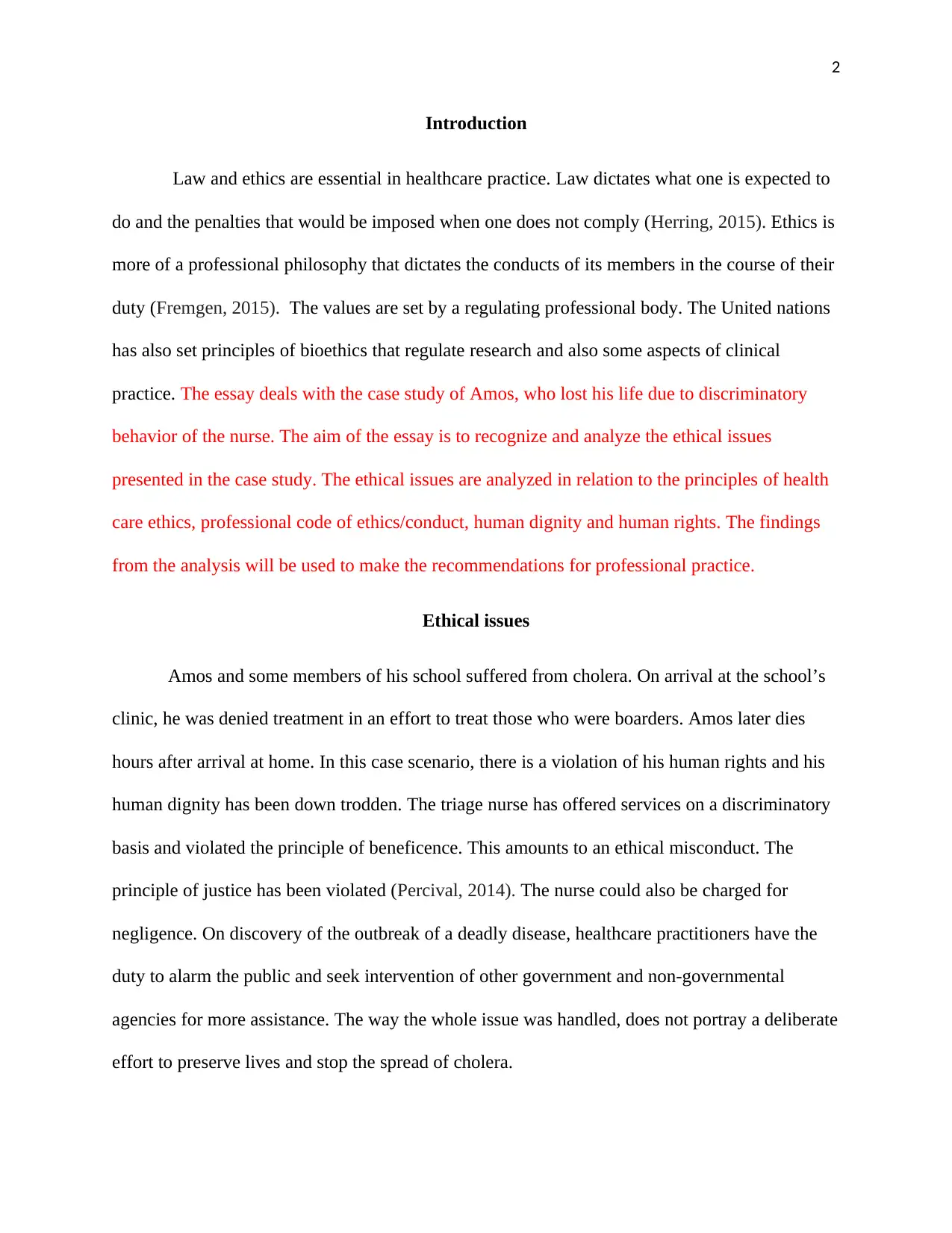
2
Introduction
Law and ethics are essential in healthcare practice. Law dictates what one is expected to
do and the penalties that would be imposed when one does not comply (Herring, 2015). Ethics is
more of a professional philosophy that dictates the conducts of its members in the course of their
duty (Fremgen, 2015). The values are set by a regulating professional body. The United nations
has also set principles of bioethics that regulate research and also some aspects of clinical
practice. The essay deals with the case study of Amos, who lost his life due to discriminatory
behavior of the nurse. The aim of the essay is to recognize and analyze the ethical issues
presented in the case study. The ethical issues are analyzed in relation to the principles of health
care ethics, professional code of ethics/conduct, human dignity and human rights. The findings
from the analysis will be used to make the recommendations for professional practice.
Ethical issues
Amos and some members of his school suffered from cholera. On arrival at the school’s
clinic, he was denied treatment in an effort to treat those who were boarders. Amos later dies
hours after arrival at home. In this case scenario, there is a violation of his human rights and his
human dignity has been down trodden. The triage nurse has offered services on a discriminatory
basis and violated the principle of beneficence. This amounts to an ethical misconduct. The
principle of justice has been violated (Percival, 2014). The nurse could also be charged for
negligence. On discovery of the outbreak of a deadly disease, healthcare practitioners have the
duty to alarm the public and seek intervention of other government and non-governmental
agencies for more assistance. The way the whole issue was handled, does not portray a deliberate
effort to preserve lives and stop the spread of cholera.
Introduction
Law and ethics are essential in healthcare practice. Law dictates what one is expected to
do and the penalties that would be imposed when one does not comply (Herring, 2015). Ethics is
more of a professional philosophy that dictates the conducts of its members in the course of their
duty (Fremgen, 2015). The values are set by a regulating professional body. The United nations
has also set principles of bioethics that regulate research and also some aspects of clinical
practice. The essay deals with the case study of Amos, who lost his life due to discriminatory
behavior of the nurse. The aim of the essay is to recognize and analyze the ethical issues
presented in the case study. The ethical issues are analyzed in relation to the principles of health
care ethics, professional code of ethics/conduct, human dignity and human rights. The findings
from the analysis will be used to make the recommendations for professional practice.
Ethical issues
Amos and some members of his school suffered from cholera. On arrival at the school’s
clinic, he was denied treatment in an effort to treat those who were boarders. Amos later dies
hours after arrival at home. In this case scenario, there is a violation of his human rights and his
human dignity has been down trodden. The triage nurse has offered services on a discriminatory
basis and violated the principle of beneficence. This amounts to an ethical misconduct. The
principle of justice has been violated (Percival, 2014). The nurse could also be charged for
negligence. On discovery of the outbreak of a deadly disease, healthcare practitioners have the
duty to alarm the public and seek intervention of other government and non-governmental
agencies for more assistance. The way the whole issue was handled, does not portray a deliberate
effort to preserve lives and stop the spread of cholera.
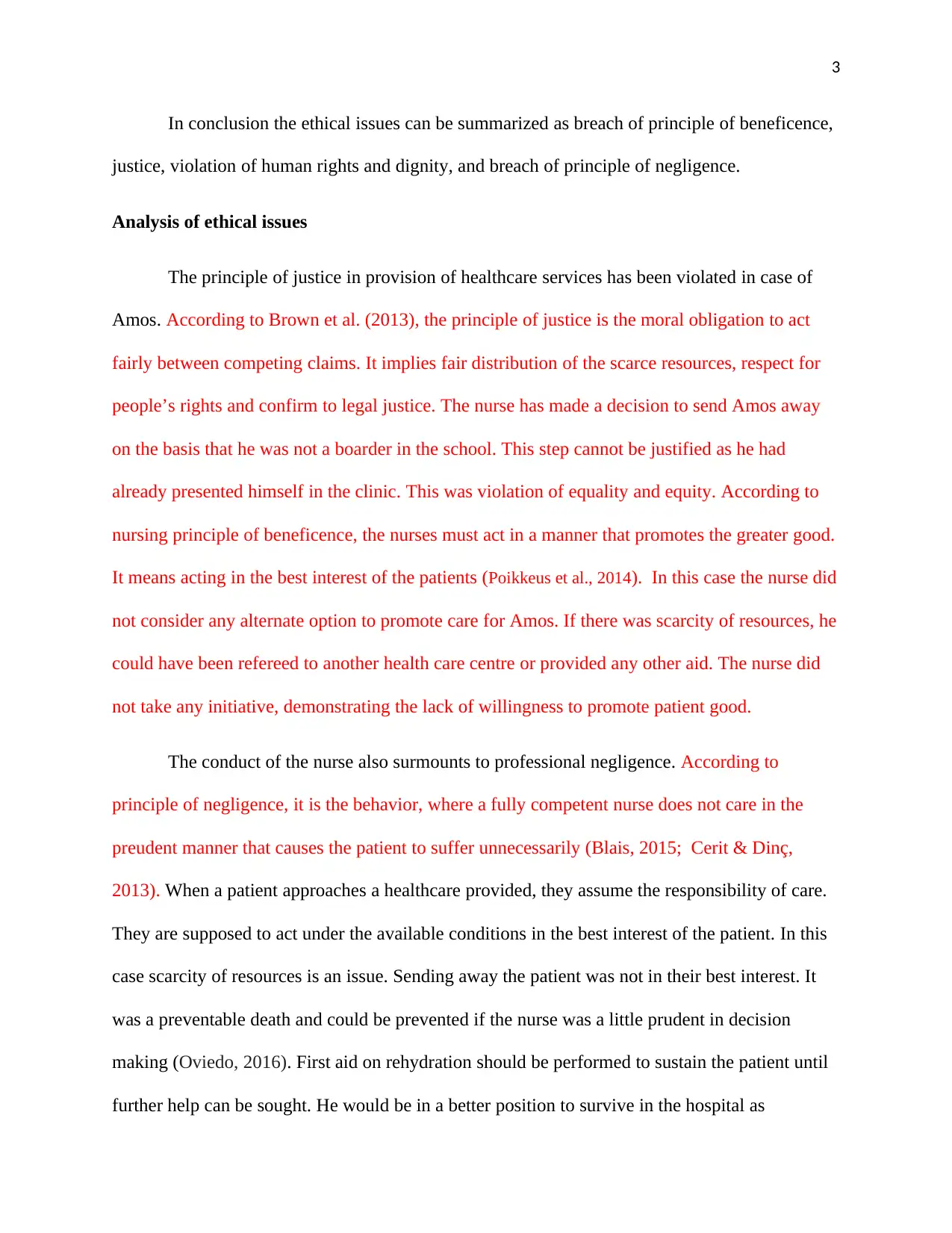
3
In conclusion the ethical issues can be summarized as breach of principle of beneficence,
justice, violation of human rights and dignity, and breach of principle of negligence.
Analysis of ethical issues
The principle of justice in provision of healthcare services has been violated in case of
Amos. According to Brown et al. (2013), the principle of justice is the moral obligation to act
fairly between competing claims. It implies fair distribution of the scarce resources, respect for
people’s rights and confirm to legal justice. The nurse has made a decision to send Amos away
on the basis that he was not a boarder in the school. This step cannot be justified as he had
already presented himself in the clinic. This was violation of equality and equity. According to
nursing principle of beneficence, the nurses must act in a manner that promotes the greater good.
It means acting in the best interest of the patients (Poikkeus et al., 2014). In this case the nurse did
not consider any alternate option to promote care for Amos. If there was scarcity of resources, he
could have been refereed to another health care centre or provided any other aid. The nurse did
not take any initiative, demonstrating the lack of willingness to promote patient good.
The conduct of the nurse also surmounts to professional negligence. According to
principle of negligence, it is the behavior, where a fully competent nurse does not care in the
preudent manner that causes the patient to suffer unnecessarily (Blais, 2015; Cerit & Dinç,
2013). When a patient approaches a healthcare provided, they assume the responsibility of care.
They are supposed to act under the available conditions in the best interest of the patient. In this
case scarcity of resources is an issue. Sending away the patient was not in their best interest. It
was a preventable death and could be prevented if the nurse was a little prudent in decision
making (Oviedo, 2016). First aid on rehydration should be performed to sustain the patient until
further help can be sought. He would be in a better position to survive in the hospital as
In conclusion the ethical issues can be summarized as breach of principle of beneficence,
justice, violation of human rights and dignity, and breach of principle of negligence.
Analysis of ethical issues
The principle of justice in provision of healthcare services has been violated in case of
Amos. According to Brown et al. (2013), the principle of justice is the moral obligation to act
fairly between competing claims. It implies fair distribution of the scarce resources, respect for
people’s rights and confirm to legal justice. The nurse has made a decision to send Amos away
on the basis that he was not a boarder in the school. This step cannot be justified as he had
already presented himself in the clinic. This was violation of equality and equity. According to
nursing principle of beneficence, the nurses must act in a manner that promotes the greater good.
It means acting in the best interest of the patients (Poikkeus et al., 2014). In this case the nurse did
not consider any alternate option to promote care for Amos. If there was scarcity of resources, he
could have been refereed to another health care centre or provided any other aid. The nurse did
not take any initiative, demonstrating the lack of willingness to promote patient good.
The conduct of the nurse also surmounts to professional negligence. According to
principle of negligence, it is the behavior, where a fully competent nurse does not care in the
preudent manner that causes the patient to suffer unnecessarily (Blais, 2015; Cerit & Dinç,
2013). When a patient approaches a healthcare provided, they assume the responsibility of care.
They are supposed to act under the available conditions in the best interest of the patient. In this
case scarcity of resources is an issue. Sending away the patient was not in their best interest. It
was a preventable death and could be prevented if the nurse was a little prudent in decision
making (Oviedo, 2016). First aid on rehydration should be performed to sustain the patient until
further help can be sought. He would be in a better position to survive in the hospital as
⊘ This is a preview!⊘
Do you want full access?
Subscribe today to unlock all pages.

Trusted by 1+ million students worldwide
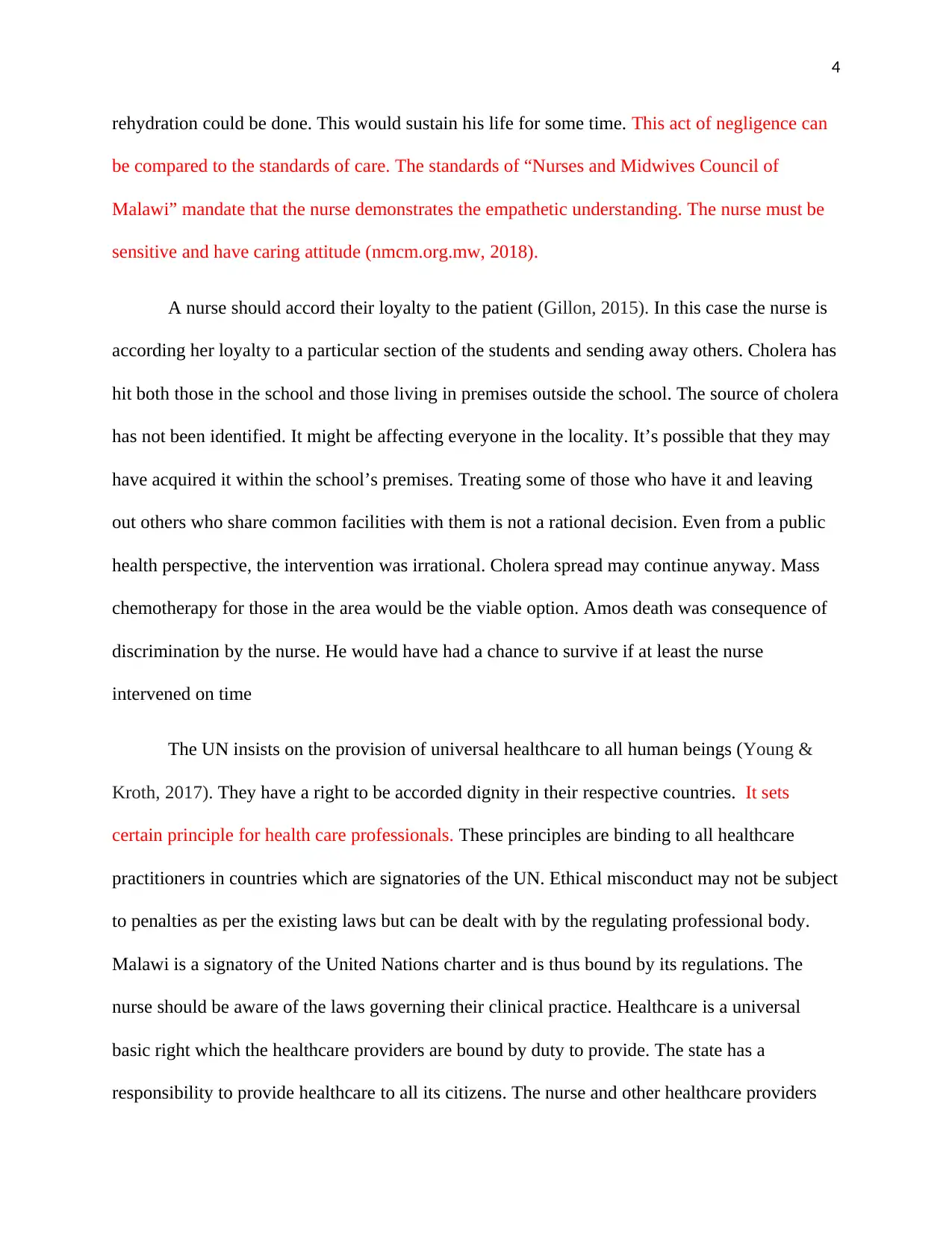
4
rehydration could be done. This would sustain his life for some time. This act of negligence can
be compared to the standards of care. The standards of “Nurses and Midwives Council of
Malawi” mandate that the nurse demonstrates the empathetic understanding. The nurse must be
sensitive and have caring attitude (nmcm.org.mw, 2018).
A nurse should accord their loyalty to the patient (Gillon, 2015). In this case the nurse is
according her loyalty to a particular section of the students and sending away others. Cholera has
hit both those in the school and those living in premises outside the school. The source of cholera
has not been identified. It might be affecting everyone in the locality. It’s possible that they may
have acquired it within the school’s premises. Treating some of those who have it and leaving
out others who share common facilities with them is not a rational decision. Even from a public
health perspective, the intervention was irrational. Cholera spread may continue anyway. Mass
chemotherapy for those in the area would be the viable option. Amos death was consequence of
discrimination by the nurse. He would have had a chance to survive if at least the nurse
intervened on time
The UN insists on the provision of universal healthcare to all human beings (Young &
Kroth, 2017). They have a right to be accorded dignity in their respective countries. It sets
certain principle for health care professionals. These principles are binding to all healthcare
practitioners in countries which are signatories of the UN. Ethical misconduct may not be subject
to penalties as per the existing laws but can be dealt with by the regulating professional body.
Malawi is a signatory of the United Nations charter and is thus bound by its regulations. The
nurse should be aware of the laws governing their clinical practice. Healthcare is a universal
basic right which the healthcare providers are bound by duty to provide. The state has a
responsibility to provide healthcare to all its citizens. The nurse and other healthcare providers
rehydration could be done. This would sustain his life for some time. This act of negligence can
be compared to the standards of care. The standards of “Nurses and Midwives Council of
Malawi” mandate that the nurse demonstrates the empathetic understanding. The nurse must be
sensitive and have caring attitude (nmcm.org.mw, 2018).
A nurse should accord their loyalty to the patient (Gillon, 2015). In this case the nurse is
according her loyalty to a particular section of the students and sending away others. Cholera has
hit both those in the school and those living in premises outside the school. The source of cholera
has not been identified. It might be affecting everyone in the locality. It’s possible that they may
have acquired it within the school’s premises. Treating some of those who have it and leaving
out others who share common facilities with them is not a rational decision. Even from a public
health perspective, the intervention was irrational. Cholera spread may continue anyway. Mass
chemotherapy for those in the area would be the viable option. Amos death was consequence of
discrimination by the nurse. He would have had a chance to survive if at least the nurse
intervened on time
The UN insists on the provision of universal healthcare to all human beings (Young &
Kroth, 2017). They have a right to be accorded dignity in their respective countries. It sets
certain principle for health care professionals. These principles are binding to all healthcare
practitioners in countries which are signatories of the UN. Ethical misconduct may not be subject
to penalties as per the existing laws but can be dealt with by the regulating professional body.
Malawi is a signatory of the United Nations charter and is thus bound by its regulations. The
nurse should be aware of the laws governing their clinical practice. Healthcare is a universal
basic right which the healthcare providers are bound by duty to provide. The state has a
responsibility to provide healthcare to all its citizens. The nurse and other healthcare providers
Paraphrase This Document
Need a fresh take? Get an instant paraphrase of this document with our AI Paraphraser
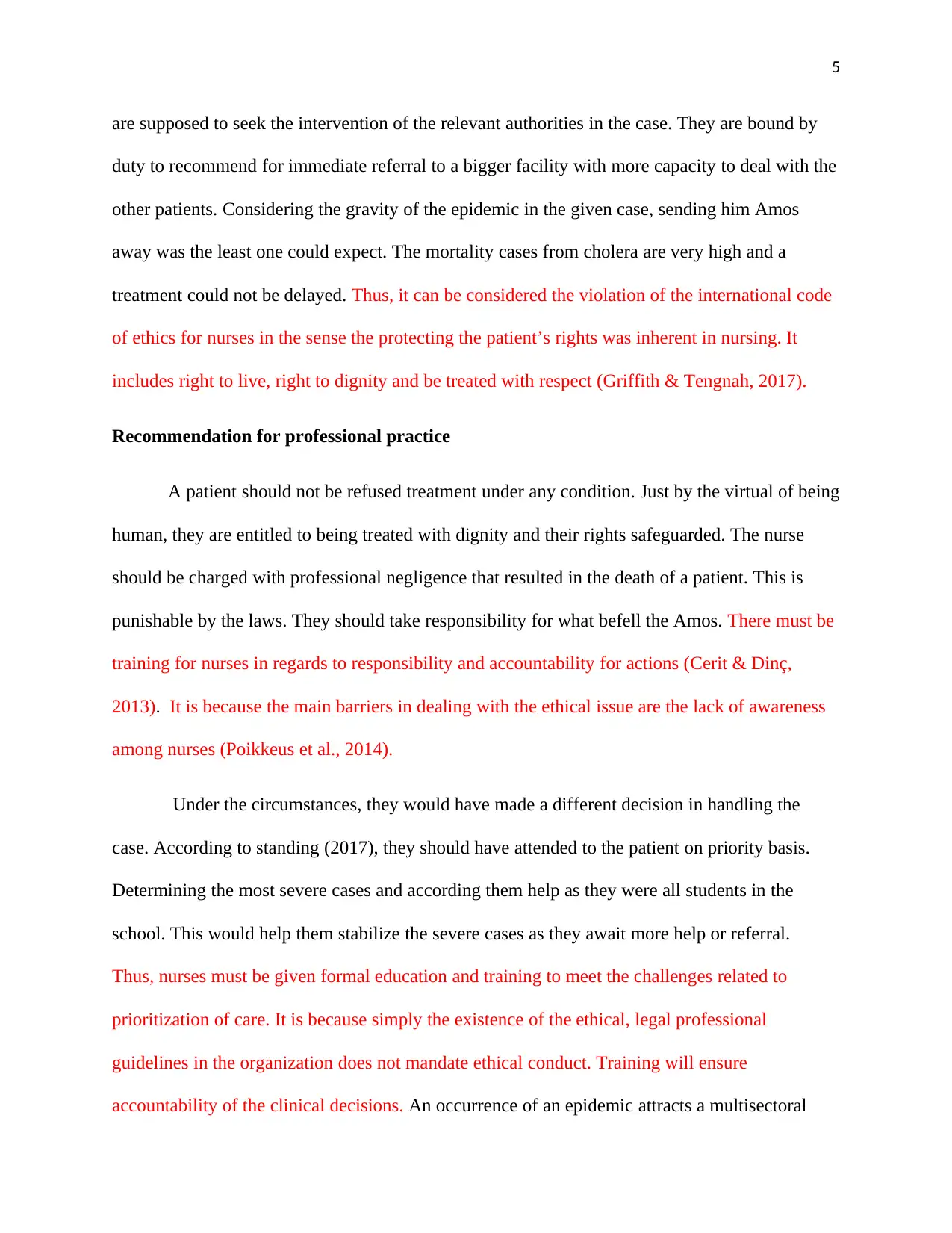
5
are supposed to seek the intervention of the relevant authorities in the case. They are bound by
duty to recommend for immediate referral to a bigger facility with more capacity to deal with the
other patients. Considering the gravity of the epidemic in the given case, sending him Amos
away was the least one could expect. The mortality cases from cholera are very high and a
treatment could not be delayed. Thus, it can be considered the violation of the international code
of ethics for nurses in the sense the protecting the patient’s rights was inherent in nursing. It
includes right to live, right to dignity and be treated with respect (Griffith & Tengnah, 2017).
Recommendation for professional practice
A patient should not be refused treatment under any condition. Just by the virtual of being
human, they are entitled to being treated with dignity and their rights safeguarded. The nurse
should be charged with professional negligence that resulted in the death of a patient. This is
punishable by the laws. They should take responsibility for what befell the Amos. There must be
training for nurses in regards to responsibility and accountability for actions (Cerit & Dinç,
2013). It is because the main barriers in dealing with the ethical issue are the lack of awareness
among nurses (Poikkeus et al., 2014).
Under the circumstances, they would have made a different decision in handling the
case. According to standing (2017), they should have attended to the patient on priority basis.
Determining the most severe cases and according them help as they were all students in the
school. This would help them stabilize the severe cases as they await more help or referral.
Thus, nurses must be given formal education and training to meet the challenges related to
prioritization of care. It is because simply the existence of the ethical, legal professional
guidelines in the organization does not mandate ethical conduct. Training will ensure
accountability of the clinical decisions. An occurrence of an epidemic attracts a multisectoral
are supposed to seek the intervention of the relevant authorities in the case. They are bound by
duty to recommend for immediate referral to a bigger facility with more capacity to deal with the
other patients. Considering the gravity of the epidemic in the given case, sending him Amos
away was the least one could expect. The mortality cases from cholera are very high and a
treatment could not be delayed. Thus, it can be considered the violation of the international code
of ethics for nurses in the sense the protecting the patient’s rights was inherent in nursing. It
includes right to live, right to dignity and be treated with respect (Griffith & Tengnah, 2017).
Recommendation for professional practice
A patient should not be refused treatment under any condition. Just by the virtual of being
human, they are entitled to being treated with dignity and their rights safeguarded. The nurse
should be charged with professional negligence that resulted in the death of a patient. This is
punishable by the laws. They should take responsibility for what befell the Amos. There must be
training for nurses in regards to responsibility and accountability for actions (Cerit & Dinç,
2013). It is because the main barriers in dealing with the ethical issue are the lack of awareness
among nurses (Poikkeus et al., 2014).
Under the circumstances, they would have made a different decision in handling the
case. According to standing (2017), they should have attended to the patient on priority basis.
Determining the most severe cases and according them help as they were all students in the
school. This would help them stabilize the severe cases as they await more help or referral.
Thus, nurses must be given formal education and training to meet the challenges related to
prioritization of care. It is because simply the existence of the ethical, legal professional
guidelines in the organization does not mandate ethical conduct. Training will ensure
accountability of the clinical decisions. An occurrence of an epidemic attracts a multisectoral
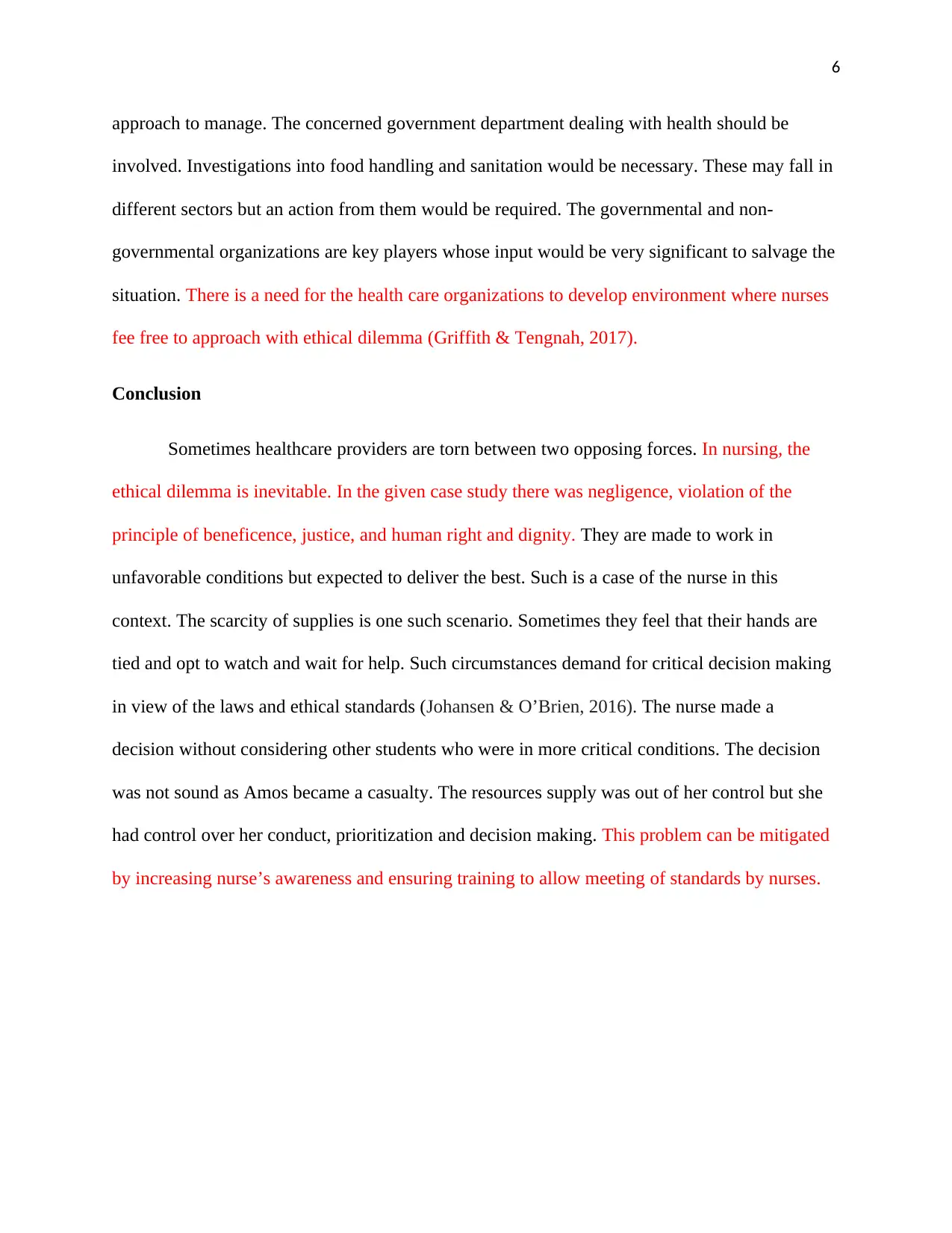
6
approach to manage. The concerned government department dealing with health should be
involved. Investigations into food handling and sanitation would be necessary. These may fall in
different sectors but an action from them would be required. The governmental and non-
governmental organizations are key players whose input would be very significant to salvage the
situation. There is a need for the health care organizations to develop environment where nurses
fee free to approach with ethical dilemma (Griffith & Tengnah, 2017).
Conclusion
Sometimes healthcare providers are torn between two opposing forces. In nursing, the
ethical dilemma is inevitable. In the given case study there was negligence, violation of the
principle of beneficence, justice, and human right and dignity. They are made to work in
unfavorable conditions but expected to deliver the best. Such is a case of the nurse in this
context. The scarcity of supplies is one such scenario. Sometimes they feel that their hands are
tied and opt to watch and wait for help. Such circumstances demand for critical decision making
in view of the laws and ethical standards (Johansen & O’Brien, 2016). The nurse made a
decision without considering other students who were in more critical conditions. The decision
was not sound as Amos became a casualty. The resources supply was out of her control but she
had control over her conduct, prioritization and decision making. This problem can be mitigated
by increasing nurse’s awareness and ensuring training to allow meeting of standards by nurses.
approach to manage. The concerned government department dealing with health should be
involved. Investigations into food handling and sanitation would be necessary. These may fall in
different sectors but an action from them would be required. The governmental and non-
governmental organizations are key players whose input would be very significant to salvage the
situation. There is a need for the health care organizations to develop environment where nurses
fee free to approach with ethical dilemma (Griffith & Tengnah, 2017).
Conclusion
Sometimes healthcare providers are torn between two opposing forces. In nursing, the
ethical dilemma is inevitable. In the given case study there was negligence, violation of the
principle of beneficence, justice, and human right and dignity. They are made to work in
unfavorable conditions but expected to deliver the best. Such is a case of the nurse in this
context. The scarcity of supplies is one such scenario. Sometimes they feel that their hands are
tied and opt to watch and wait for help. Such circumstances demand for critical decision making
in view of the laws and ethical standards (Johansen & O’Brien, 2016). The nurse made a
decision without considering other students who were in more critical conditions. The decision
was not sound as Amos became a casualty. The resources supply was out of her control but she
had control over her conduct, prioritization and decision making. This problem can be mitigated
by increasing nurse’s awareness and ensuring training to allow meeting of standards by nurses.
⊘ This is a preview!⊘
Do you want full access?
Subscribe today to unlock all pages.

Trusted by 1+ million students worldwide
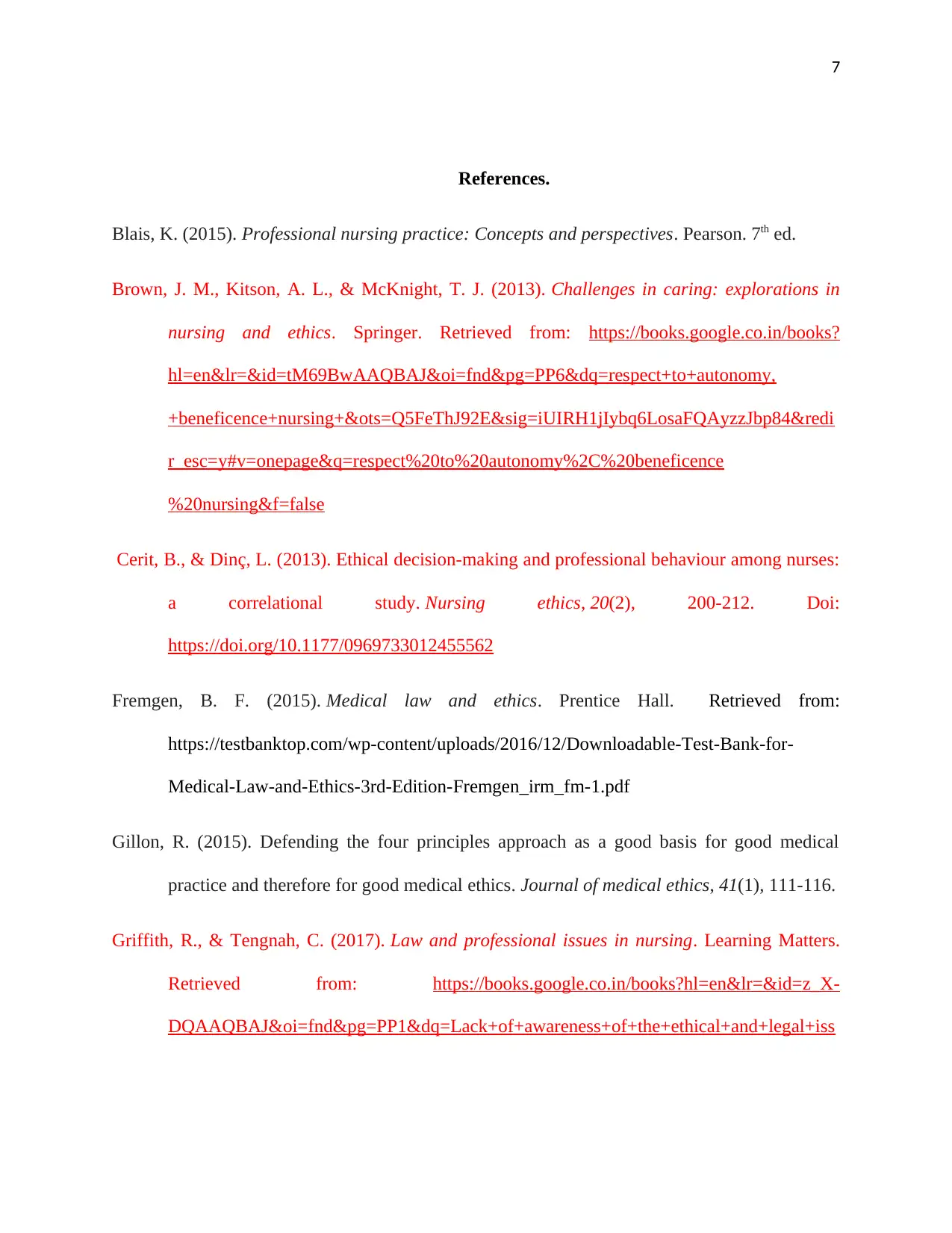
7
References.
Blais, K. (2015). Professional nursing practice: Concepts and perspectives. Pearson. 7th ed.
Brown, J. M., Kitson, A. L., & McKnight, T. J. (2013). Challenges in caring: explorations in
nursing and ethics. Springer. Retrieved from: https://books.google.co.in/books?
hl=en&lr=&id=tM69BwAAQBAJ&oi=fnd&pg=PP6&dq=respect+to+autonomy,
+beneficence+nursing+&ots=Q5FeThJ92E&sig=iUIRH1jIybq6LosaFQAyzzJbp84&redi
r_esc=y#v=onepage&q=respect%20to%20autonomy%2C%20beneficence
%20nursing&f=false
Cerit, B., & Dinç, L. (2013). Ethical decision-making and professional behaviour among nurses:
a correlational study. Nursing ethics, 20(2), 200-212. Doi:
https://doi.org/10.1177/0969733012455562
Fremgen, B. F. (2015). Medical law and ethics. Prentice Hall. Retrieved from:
https://testbanktop.com/wp-content/uploads/2016/12/Downloadable-Test-Bank-for-
Medical-Law-and-Ethics-3rd-Edition-Fremgen_irm_fm-1.pdf
Gillon, R. (2015). Defending the four principles approach as a good basis for good medical
practice and therefore for good medical ethics. Journal of medical ethics, 41(1), 111-116.
Griffith, R., & Tengnah, C. (2017). Law and professional issues in nursing. Learning Matters.
Retrieved from: https://books.google.co.in/books?hl=en&lr=&id=z_X-
DQAAQBAJ&oi=fnd&pg=PP1&dq=Lack+of+awareness+of+the+ethical+and+legal+iss
References.
Blais, K. (2015). Professional nursing practice: Concepts and perspectives. Pearson. 7th ed.
Brown, J. M., Kitson, A. L., & McKnight, T. J. (2013). Challenges in caring: explorations in
nursing and ethics. Springer. Retrieved from: https://books.google.co.in/books?
hl=en&lr=&id=tM69BwAAQBAJ&oi=fnd&pg=PP6&dq=respect+to+autonomy,
+beneficence+nursing+&ots=Q5FeThJ92E&sig=iUIRH1jIybq6LosaFQAyzzJbp84&redi
r_esc=y#v=onepage&q=respect%20to%20autonomy%2C%20beneficence
%20nursing&f=false
Cerit, B., & Dinç, L. (2013). Ethical decision-making and professional behaviour among nurses:
a correlational study. Nursing ethics, 20(2), 200-212. Doi:
https://doi.org/10.1177/0969733012455562
Fremgen, B. F. (2015). Medical law and ethics. Prentice Hall. Retrieved from:
https://testbanktop.com/wp-content/uploads/2016/12/Downloadable-Test-Bank-for-
Medical-Law-and-Ethics-3rd-Edition-Fremgen_irm_fm-1.pdf
Gillon, R. (2015). Defending the four principles approach as a good basis for good medical
practice and therefore for good medical ethics. Journal of medical ethics, 41(1), 111-116.
Griffith, R., & Tengnah, C. (2017). Law and professional issues in nursing. Learning Matters.
Retrieved from: https://books.google.co.in/books?hl=en&lr=&id=z_X-
DQAAQBAJ&oi=fnd&pg=PP1&dq=Lack+of+awareness+of+the+ethical+and+legal+iss
Paraphrase This Document
Need a fresh take? Get an instant paraphrase of this document with our AI Paraphraser
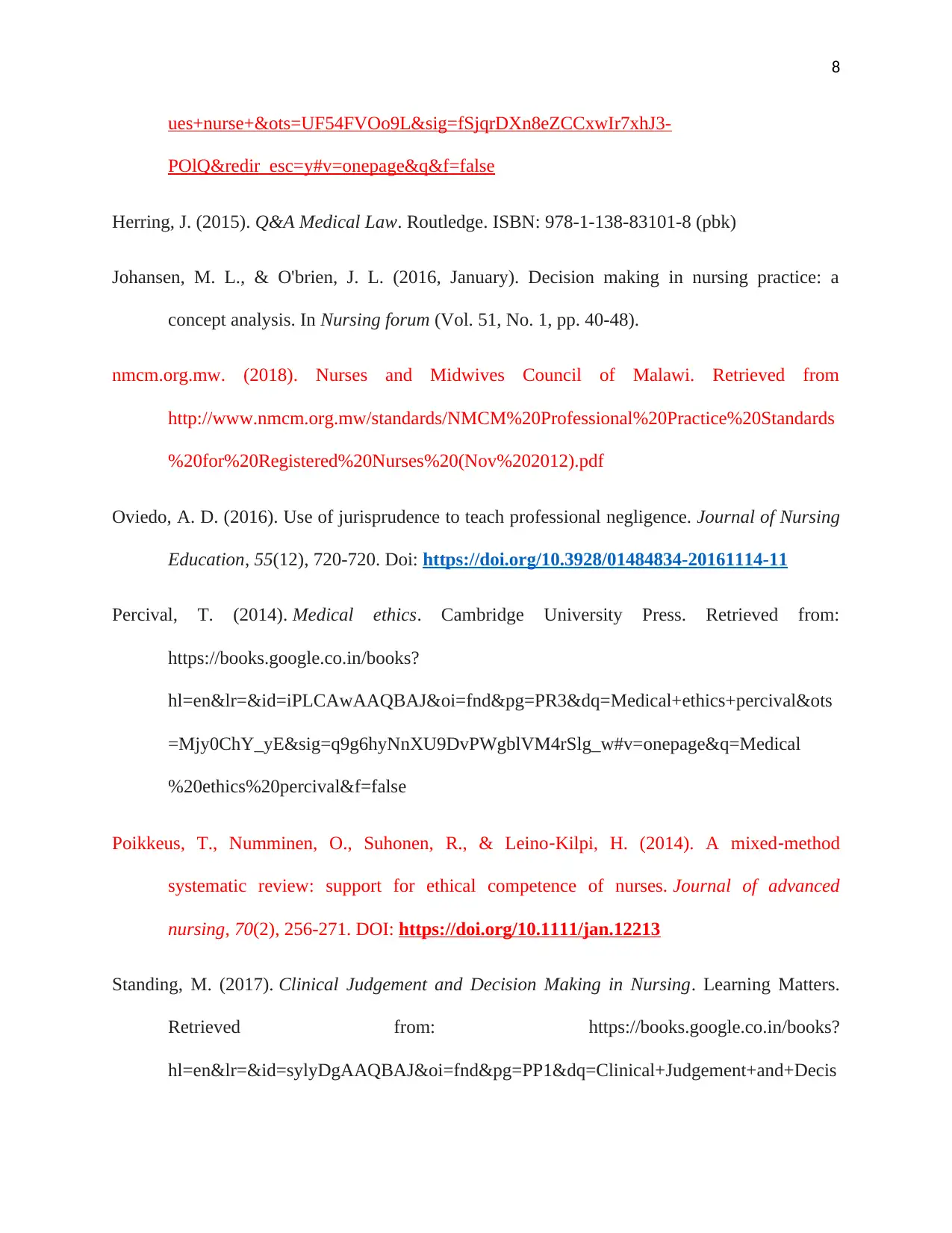
8
ues+nurse+&ots=UF54FVOo9L&sig=fSjqrDXn8eZCCxwIr7xhJ3-
POlQ&redir_esc=y#v=onepage&q&f=false
Herring, J. (2015). Q&A Medical Law. Routledge. ISBN: 978-1-138-83101-8 (pbk)
Johansen, M. L., & O'brien, J. L. (2016, January). Decision making in nursing practice: a
concept analysis. In Nursing forum (Vol. 51, No. 1, pp. 40-48).
nmcm.org.mw. (2018). Nurses and Midwives Council of Malawi. Retrieved from
http://www.nmcm.org.mw/standards/NMCM%20Professional%20Practice%20Standards
%20for%20Registered%20Nurses%20(Nov%202012).pdf
Oviedo, A. D. (2016). Use of jurisprudence to teach professional negligence. Journal of Nursing
Education, 55(12), 720-720. Doi: https://doi.org/10.3928/01484834-20161114-11
Percival, T. (2014). Medical ethics. Cambridge University Press. Retrieved from:
https://books.google.co.in/books?
hl=en&lr=&id=iPLCAwAAQBAJ&oi=fnd&pg=PR3&dq=Medical+ethics+percival&ots
=Mjy0ChY_yE&sig=q9g6hyNnXU9DvPWgblVM4rSlg_w#v=onepage&q=Medical
%20ethics%20percival&f=false
Poikkeus, T., Numminen, O., Suhonen, R., & Leino‐Kilpi, H. (2014). A mixed‐method
systematic review: support for ethical competence of nurses. Journal of advanced
nursing, 70(2), 256-271. DOI: https://doi.org/10.1111/jan.12213
Standing, M. (2017). Clinical Judgement and Decision Making in Nursing. Learning Matters.
Retrieved from: https://books.google.co.in/books?
hl=en&lr=&id=sylyDgAAQBAJ&oi=fnd&pg=PP1&dq=Clinical+Judgement+and+Decis
ues+nurse+&ots=UF54FVOo9L&sig=fSjqrDXn8eZCCxwIr7xhJ3-
POlQ&redir_esc=y#v=onepage&q&f=false
Herring, J. (2015). Q&A Medical Law. Routledge. ISBN: 978-1-138-83101-8 (pbk)
Johansen, M. L., & O'brien, J. L. (2016, January). Decision making in nursing practice: a
concept analysis. In Nursing forum (Vol. 51, No. 1, pp. 40-48).
nmcm.org.mw. (2018). Nurses and Midwives Council of Malawi. Retrieved from
http://www.nmcm.org.mw/standards/NMCM%20Professional%20Practice%20Standards
%20for%20Registered%20Nurses%20(Nov%202012).pdf
Oviedo, A. D. (2016). Use of jurisprudence to teach professional negligence. Journal of Nursing
Education, 55(12), 720-720. Doi: https://doi.org/10.3928/01484834-20161114-11
Percival, T. (2014). Medical ethics. Cambridge University Press. Retrieved from:
https://books.google.co.in/books?
hl=en&lr=&id=iPLCAwAAQBAJ&oi=fnd&pg=PR3&dq=Medical+ethics+percival&ots
=Mjy0ChY_yE&sig=q9g6hyNnXU9DvPWgblVM4rSlg_w#v=onepage&q=Medical
%20ethics%20percival&f=false
Poikkeus, T., Numminen, O., Suhonen, R., & Leino‐Kilpi, H. (2014). A mixed‐method
systematic review: support for ethical competence of nurses. Journal of advanced
nursing, 70(2), 256-271. DOI: https://doi.org/10.1111/jan.12213
Standing, M. (2017). Clinical Judgement and Decision Making in Nursing. Learning Matters.
Retrieved from: https://books.google.co.in/books?
hl=en&lr=&id=sylyDgAAQBAJ&oi=fnd&pg=PP1&dq=Clinical+Judgement+and+Decis
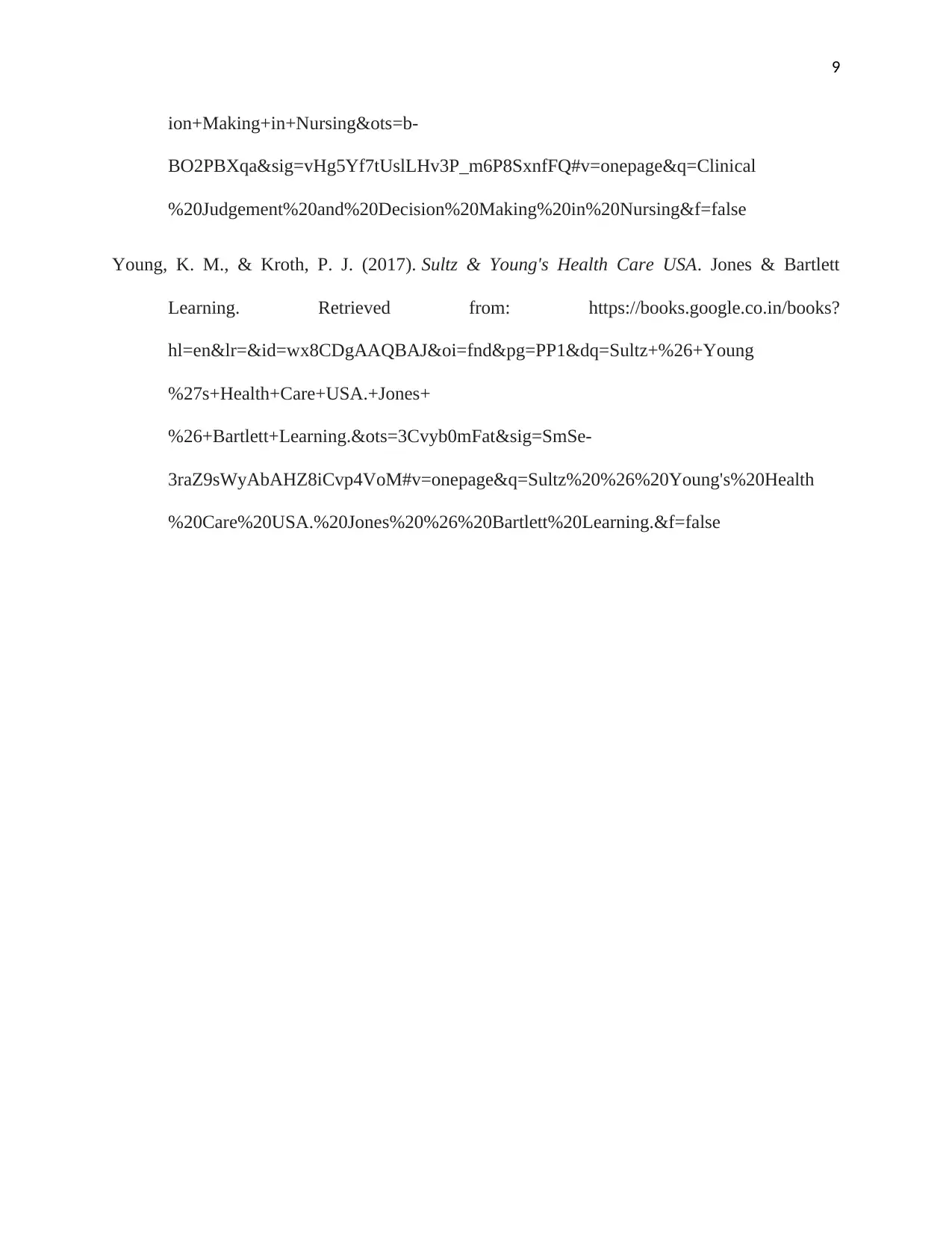
9
ion+Making+in+Nursing&ots=b-
BO2PBXqa&sig=vHg5Yf7tUslLHv3P_m6P8SxnfFQ#v=onepage&q=Clinical
%20Judgement%20and%20Decision%20Making%20in%20Nursing&f=false
Young, K. M., & Kroth, P. J. (2017). Sultz & Young's Health Care USA. Jones & Bartlett
Learning. Retrieved from: https://books.google.co.in/books?
hl=en&lr=&id=wx8CDgAAQBAJ&oi=fnd&pg=PP1&dq=Sultz+%26+Young
%27s+Health+Care+USA.+Jones+
%26+Bartlett+Learning.&ots=3Cvyb0mFat&sig=SmSe-
3raZ9sWyAbAHZ8iCvp4VoM#v=onepage&q=Sultz%20%26%20Young's%20Health
%20Care%20USA.%20Jones%20%26%20Bartlett%20Learning.&f=false
ion+Making+in+Nursing&ots=b-
BO2PBXqa&sig=vHg5Yf7tUslLHv3P_m6P8SxnfFQ#v=onepage&q=Clinical
%20Judgement%20and%20Decision%20Making%20in%20Nursing&f=false
Young, K. M., & Kroth, P. J. (2017). Sultz & Young's Health Care USA. Jones & Bartlett
Learning. Retrieved from: https://books.google.co.in/books?
hl=en&lr=&id=wx8CDgAAQBAJ&oi=fnd&pg=PP1&dq=Sultz+%26+Young
%27s+Health+Care+USA.+Jones+
%26+Bartlett+Learning.&ots=3Cvyb0mFat&sig=SmSe-
3raZ9sWyAbAHZ8iCvp4VoM#v=onepage&q=Sultz%20%26%20Young's%20Health
%20Care%20USA.%20Jones%20%26%20Bartlett%20Learning.&f=false
⊘ This is a preview!⊘
Do you want full access?
Subscribe today to unlock all pages.

Trusted by 1+ million students worldwide
1 out of 9
Related Documents
Your All-in-One AI-Powered Toolkit for Academic Success.
+13062052269
info@desklib.com
Available 24*7 on WhatsApp / Email
![[object Object]](/_next/static/media/star-bottom.7253800d.svg)
Unlock your academic potential
Copyright © 2020–2025 A2Z Services. All Rights Reserved. Developed and managed by ZUCOL.





